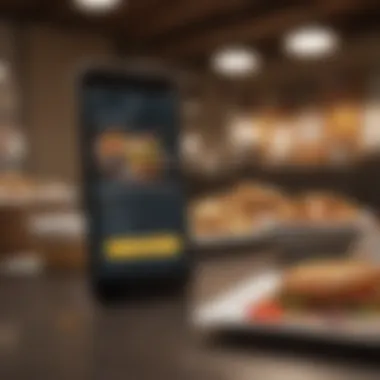Evaluating Food Delivery Apps for Optimal Dining


Intro
In recent years, food delivery apps have fundamentally changed how consumers experience dining. With the convenience of placing an order from the comfort of home, the popularity of these platforms has surged. This article explores the most prominent options available, dissecting various features that can influence users' choices.
Understanding the factors that contribute to the effectiveness of these apps is essential for both casual diners and those seeking a reliable solution for meals. A comprehensive evaluation can help users navigate a crowded market, identifying not only the best apps for their needs but also understanding the underlying dynamics at play.
By examining usability, restaurant selection, pricing, delivery speed, and customer service, this article will provide insights that are crucial for informed decision-making in the world of food delivery.
Market Analysis
Current Market Trends
The food delivery app sector has seen a notable increase in user adoption, driven by lifestyle changes and improved technology. Mobile applications have streamlined the ordering process, making it a preferred choice for many. Key players such as Uber Eats, DoorDash, and Grubhub dominate the landscape, but new entrants continue to emerge, reflecting a competitive atmosphere.
Industry-specific Analysis
The competition varies depending on regional preferences and the concentration of restaurants offering delivery services. For instance, markets that show high demand, like major cities, often boast multiple options, whereas smaller towns might have limited choices. Furthermore, consumer preferences are shifting, with a growing appetite for healthy options and local cuisines challenging traditional fast-food offerings.
Market Volatility and Risk Factors
As with any industry, the food delivery market grapples with volatility and risk factors. Economic fluctuations can affect consumer spending habits. Changes in restaurant partnerships or food sourcing can impact operational efficiency and, ultimately, the user experience. In this environment, maintaining a flexible approach is vital for these apps to adapt quickly to unexpected challenges.
"The adaptability of food delivery apps will decide their longevity in a fast-evolving market where consumer tastes are constantly shifting."
Economic Insights
Economic Indicators Overview
Economic indicators play a crucial role in shaping the food delivery market. Factors such as disposable income and unemployment rates can significantly influence consumer behavior. During economic downturns, budgets tighten, causing a decline in app usage.
Global Economic Trends
Globally, a rise in digital transactions and an emphasis on convenience are pushing consumers towards online food delivery. Many countries report increasing smartphone usage, which drives the adoption rate of these apps.
Impact of Economic Events on Markets
Events like the Covid-19 pandemic drastically impacted restaurant operations and consumer purchasing habits. With many dining options limited, food delivery options surged in popularity. The long-term implications of such events continue to shape market strategies.
Expert Financial Advice
Investing for Beginners
For those interested in investing in food delivery services, understanding the basics is crucial. Research the apps' performance metrics, market share, and customer reviews. This information can aid in identifying potential growth or stability in chosen platforms.
Advanced Trading Techniques
More experienced investors can explore options like diversification across several food delivery stocks to mitigate risk. For instance, observing market trends around holidays can provide insights into seasonal spikes in orders.
Wealth Preservation Strategies
To preserve wealth in the food delivery space, consider investing in established companies with a record of resilience. Platforms that continuously innovate and expand their service offerings may present more stable opportunities for financial growth.
Foreword to Food Delivery Apps
The ecosystems for dining have evolved dramatically, particularly with the advent of food delivery applications. The convenience they offer fits into the busy schedules of today’s society. The importance of food delivery apps lies not only in their ease of use but also in their ability to connect consumers with restaurants they might not discover otherwise. In a rapidly urbanizing world, where time is of the essence, understanding these platforms is essential for optimal dining experiences.
The Rise of Food Delivery Services


Food delivery services have seen tremendous growth over the past decade. The proliferation of smartphones and advanced technology has enabled consumers to order meals with just a few taps. According to a report from Wikipedia, the market has expanded due to increased demand for convenience, a clear shift from traditional dining.
Factors contributing to this rise include:
- Technological Advancements: Enhanced app interfaces provide easy navigation.
- Diverse Options: Consumers can choose from a variety of cuisines and dining styles.
- Changing Consumer Lifestyles: Busier schedules have led to reduced cooking at home.
This growth presents an opportunity for restaurants to reach more customers. Those that may struggle with foot traffic can thrive in the online space, and this shift has altered the landscape of the food service industry significantly.
Consumer Trends and Demands
Today’s consumers display distinct preferences that shape the food delivery market. They seek not only convenience but also unique experiences from their dining choices. Recent trends reveal that:
- Health Consciousness: A rising interest in healthy options has influenced many food delivery apps to offer healthier menu selections, including vegan and gluten-free choices.
- Sustainability: More consumers express interest in sustainable practices. Companies are adapting by offering eco-friendly packaging and sourcing local ingredients.
- Customization: Apps that allow for meal customization are increasingly popular, catering to individual tastes and dietary needs.
These trends reflect a growing expectation for apps to provide tailored solutions. As consumer demands evolve, food delivery platforms must adapt by embracing flexibility and innovation.
"Convenience has become an essential aspect of dining, fundamentally changing how we source our meals."
Understanding these dynamics is crucial for selecting the right food delivery app. Subsequently, this article will delve into the criteria for evaluating these applications, ensuring that consumers make informed decisions.
Criteria for Selecting a Food Delivery App
Choosing the right food delivery app is crucial in today's fast-paced environment. The variety of options available can create confusion. Thus, establishing clear criteria for evaluation helps streamline the decision-making process. Understanding these criteria enables users to make choices based on their unique requirements and preferences.
Users prioritize several elements when selecting a food delivery app. User interface and experience is significant, as it influences how easily one can navigate the app. A clean design with logical organization enhances usability. Furthermore, restaurant availability and diversity are essential. The selection of dining options affects consumer satisfaction. Access to various cuisines and local restaurants can greatly improve the dining experience.
Pricing models also merit consideration. Pricing and fees structure can affect overall satisfaction with service. Hidden fees or unclear pricing can lead to frustration. Additionally, delivery speed and efficiency are non-negotiable in selecting an app. Consumers expect prompt service to meet their busy schedules. Finally, assessing the quality of customer support is paramount. Good support can mitigate potential issues, leading to a better overall experience.
User Interface and Experience
The importance of user interface and overall experience cannot be overstated. In a saturated market, an intuitive and pleasant app can significantly enhance user retention and satisfaction. Users prefer apps that are straightforward and aesthetically appealing. Streamlined navigation allows individuals to locate food options quickly and place orders with minimal hassle.
Moreover, features such as saved preferences, easy order tracking, and personalized recommendations create a tailored experience. Apps that highlight user-friendly designs often receive better reviews, reinforcing their market position.
Restaurant Availability and Diversity
The success of food delivery apps largely hinges on restaurant availability and diversity. Consumers desire a wide range of choices spanning various cuisines and dietary preferences. An app that partners with both popular chains and unique local eateries can attract more users.
When exploring this feature, consider app partnerships with well-known brands alongside offerings from lesser-known but high-quality restaurants. The diversity of options allows users to explore new foods and cuisines, enhancing user satisfaction and engagement over time.
Pricing and Fees Structure
Pricing transparency is a critical aspect of user experience. Understanding the pricing and fees structure is vital for consumers. Apps often employ various models, such as delivery fees, service charges, and minimum order requirements. These can significantly impact the total cost significantly.
Consumers should assess each app's pricing models, looking for clarity in fees. Apps that offer promotions or loyalty rewards may also present better value over time. Being aware of the complete cost can prevent surprises when the bill arrives.
Delivery Speed and Efficiency
In the current climate, delivery speed and efficiency are paramount for consumers. Fast and reliable delivery impacts consumer satisfaction and repeat usage. Users tend to have high expectations regarding how quickly their food arrives.
Factors influencing delivery efficiency include app logistics, restaurant partnership quality, and order management systems. Assessing reviews that highlight timely deliveries can aid in evaluating potential apps. Higher satisfaction rates often correspond to improved logistics and streamlined operations.
Customer Support Quality
Lastly, the quality of customer support plays a vital role in the user experience. Issues can arise, and having effective support is essential. Good customer service can make the difference between a negative experience and a satisfied customer.
Users should consider apps that offer multiple ways to reach support, such as chat, email, or phone. The availability of responsive support agents often correlates with higher user satisfaction levels. Reading user feedback about customer support interactions can provide a clearer picture of an app's reliability in trouble-shooting scenarios and resolution efficiency.


In summary, understanding these criteria sharpens user focus when evaluating food delivery apps. By considering user interface, restaurant diversity, pricing transparency, delivery efficiency, and customer support, users can select an app that aligns with their dining needs.
Overview of Top Food Delivery Apps
In the current landscape of gastronomic options, food delivery apps have gained significant prominence. These applications not only ease the process of ordering food but also place a vast array of culinary experiences at users' fingertips. Evaluating the leading food delivery apps is crucial for consumers who wish to optimize their dining experience and ensure they are making informed choices. This section delves into several outstanding apps, discussing their unique features and strengths, and examining user perspectives on their performance.
With technology evolving rapidly, it is indispensable for users to understand the functionalities and limitations of these platforms. Comparing various apps provides insight into which application suits different preferences. Not everyone has the same needs when it comes to food delivery. Therefore, highlighting various apps aids users in selecting an option that aligns with their specific requirements.
Furthermore, evaluating these apps goes beyond mere preference; it encompasses the impact they have on traditional dining and the restaurant industry. By understanding the dynamics of each app, consumers can appreciate the broader implications of food delivery services.
App One: Features and Strengths
App One stands out in a crowded market due to its intuitive design and user-friendly interface. This application focuses heavily on providing a seamless experience from browsing to ordering. Key features include:
- Curated Restaurant Lists: Users are presented with personalized recommendations based on their past orders and preferences.
- Real-Time Tracking: It allows users to monitor their delivery in real-time, enhancing transparency.
- Promotions and Discounts: Regular offerings of promotions increase user engagement and loyalty.
- Assessment Tools: Users can rate and review meals, giving feedback that helps restaurants improve service quality.
These strengths create a compelling case for users seeking a reliable app with considerable restaurant options.
App Two: Comparative Analysis
In the evaluation of App Two, it becomes apparent that its breadth of restaurant variety sets it apart. By offering a diverse array of cuisine choices, this app attracts a wide audience. However, the comparative aspect reveals both benefits and downsides.
- Strengths:
- Weaknesses:
- Extensive selection of local and international cuisines.
- Frequent collaborations with local eateries, ensuring fresh and unique options.
- Prone to occasional delivery delays during peak hours.
- Pricing tends to be higher compared to competitors, leading to concerns over cost.
In summary, App Two excels in options but may fall short in speed and affordability, making it suitable for diners willing to pay a premium for variety.
App Three: User Reviews and Feedback
Focusing on App Three, the narrative can be guided by the voices of its users. Reviews consistently highlight its efficiency and responsive customer service. Users have noted:
- Quick Delivery: Most orders arrive on time or earlier than expected.
- Effective Support: The customer service is often praised for being accessible and resolving issues swiftly.
- Satisfactory Food Quality: Users report receiving meals that match restaurant standards, contributing to a positive experience.
However, some criticism surfaces regarding app glitches or occasional inaccuracies in order details. Overall, App Three garners favorable ratings for its reliability and user-centered approach.
App Four: Ideal Use Cases
When considering the best environments for App Four, diversifying its usability becomes essential. This app is ideal for specific scenarios, such as:
- Late Night Cravings: With a range of partnerships targeting late-night eateries, users can easily find food options when other services may close.
- Group Orders: The app allows for easy splitting of bills, making it suitable for parties or gatherings.
- Healthy Options: An exclusive feature includes health-focused restaurants, catering to users with dietary restrictions.
By evaluating these distinct use cases, App Four demonstrates its ability to adapt to the varied lifestyle choices of its users.
Overall, understanding these aspects of app functionality can help consumers make decisions tailored to their dining preferences.
Impact of Food Delivery Apps on Traditional Restaurants
The emergence of food delivery apps has significantly changed the landscape for traditional restaurants. Understanding this impact is crucial for recognizing how these services are reshaping the culinary business and consumer behavior in today’s market.
Business Model Shifts
Food delivery apps have prompted traditional restaurants to reevaluate and adapt their business models. Many establishments that once thrived on in-house dining are now prioritizing online orders. This shift has led to several notable changes:
- Menu Adjustments: Restaurants often revise their menus to cater specifically for delivery. The focus may lean towards items that maintain quality during transport.
- Operational Changes: With an increase in online orders, kitchens must streamline their processes. Many restaurants invest in technology to handle incoming requests and manage deliveries efficiently.
- Cost Structures: The costs associated with delivery services influence pricing strategies. Restaurants must navigate the fees imposed by delivery platforms, which can affect profit margins.


These adaptations reflect an overall trend toward efficiency and convenience, as restaurants work to remain competitive in a rapidly evolving market.
Consumer Behavior Alterations
The integration of food delivery apps has also led to noticeable changes in consumer behavior. These shifts not only affect how customers choose their meals but also redefine their expectations:
- Convenience Over Formality: Many consumers now prioritize the convenience of food delivery over the traditional dining experience. This can lead to a decline in foot traffic, especially during peak hours.
- Loyalty Dynamics: Customer loyalty is increasingly influenced by app experience rather than restaurant brand alone. Users may choose their preferred delivery app based on ease of use rather than their favorite local eatery.
- Diverse Choices: Access to a broad selection of cuisines at the touch of a button encourages exploration. This may lead some consumers to try new dining options beyond their usual preferences.
In essence, the effect of food delivery apps extends deeply into consumer choices, allowing for greater flexibility while also making the restaurant industry adopt more customer-driven approaches. In summary, food delivery services not only alter traditional restaurant operations, but they also reshape the very expectations and habits of consumers.
Challenges Faced by Food Delivery Apps
The food delivery industry has seen exponential growth, yet it is not without significant challenges. Understanding these challenges is critical for consumers and businesses alike. A clear analysis of these operational and regulatory hurdles sheds light on how apps navigate a complex landscape.
Operational Hurdles
Operational challenges can severely impact a food delivery app's performance. The first major issue is the logistics involved in food delivery. Efficiently managing delivery routes and ensuring timely arrivals can be complicated, especially in dense urban areas where traffic conditions are unpredictable. Poor logistics often lead to delayed deliveries.
- Driver Availability: Many apps depend heavily on gig economy drivers. Fluctuations in driver availability can result from various factors, including seasonal demand and personal commitments of drivers. High turnover rates among these drivers can also disrupt service consistency.
- Order Accuracy: Mistakes in order taking can lead to unsatisfied customers. If a customer receives the wrong item or a meal that does not meet their dietary restrictions, they may not use the app again. Ensuring accuracy in orders remains a fundamental challenge.
- Technology Failures: Technical glitches and server downtime can hinder the functionality of the app. Consumers expect seamless service, and any disruption can lead to customer dissatisfaction and loss of revenue.
Regulatory Considerations
Regulatory issues form another layer of complexity for food delivery apps. As these platforms continue to grow, they encounter various laws and regulations that govern their operations, which differ across regions.
- Labor Laws: Different jurisdictions have different rules regarding the treatment of gig workers. Issues include minimum wage, health benefits, and work hours. Food delivery apps must navigate these regulations to avoid legal setbacks.
- Food Safety Standards: Ensuring that food safety standards are met can be challenging. Apps must communicate effectively with restaurants to ensure compliance with health regulations, which can vary significantly.
- Zoning Laws: Local regulations may restrict where food can be delivered. Some areas may have specific zoning regulations that limit operations during certain hours, or forbid delivery to specific locations altogether.
Future Trends in Food Delivery Services
The food delivery industry is undergoing significant transformations that will shape its future. Understanding these future trends is vital for consumers and businesses alike. As technology advances and consumer preferences evolve, staying updated on these developments can lead to more efficient service and improved satisfaction.
Technological Innovations
One of the most impactful trends in food delivery apps is the integration of technological innovations. This includes a growing reliance on artificial intelligence to enhance customer service and optimize delivery routes. AI algorithms analyze data on traffic patterns, customer preferences, and restaurant performance to ensure timely deliveries. Drones and autonomous vehicles are also showing potential to change the delivery landscape.
These changes promise an increase in efficiency, reduced delivery times, and expanded service areas.
Moreover, user-friendly interfaces powered by augmented reality are being developed. These interfaces can make it easier for consumers to navigate menus and place orders. Potential customers can visualize the food in real-time, contributing to an enhanced overall experience.
"Embracing technological innovations can drastically enhance operational efficiency in food delivery."
Evolving Consumer Expectations
Consumer expectations are rapidly evolving, pushing food delivery services to adapt continuously. Today's consumers seek more than just convenience. They demand quality, sustainability, and personalized experiences. A growing number of customers prefer apps that offer organic or locally sourced options.
Moreover, transparency regarding delivery fees and times is becoming essential. Users expect clear communication about any charges before placing orders. Many prefer platforms that provide traceability of their food sources and sustainability practices. Companies that meet these expectations not only build trust but also cultivate loyal customer bases.
Consumers are also increasingly inclined toward seamless payment methods, including digital wallets and cryptocurrencies. The demand for quick, secure transactions is shaping how food delivery apps plan their payment systems.
As the industry progresses, businesses must stay attuned to these evolving consumer expectations. This adaptability not only enhances customer loyalty but also ensures long-term viability in a competitive market.
Closure: Which App is Best for You?
Choosing the right food delivery app is essential for users looking to maximize their dining experiences while also being conscious of time and costs. This article has explored various food delivery applications, detailing their strengths and weaknesses based on user trends, pricing strategies, and quality of service. Understanding these factors can empower readers to make choices that align with their individual needs, preferences, and expectations.
When evaluating food delivery apps, it is crucial to consider several specific elements that may impact your overall satisfaction. Factors like usability, availability of restaurants, fees, speed of delivery, and customer service play significant roles. By focusing on these aspects, users are more likely to find an app that not only meets their needs but also enhances their dining experience. This evaluation draws forth an interesting contrast between different applications, showing that no one app fits all.
Summary of Key Points
- Usability: A user-friendly interface can greatly enhance the ordering experience, making it critical to select an app that is intuitive.
- Restaurant Availability: Having a wide selection of restaurants ensures diverse options and can affect user satisfaction.
- Pricing and Fees: Understanding the fee structure is vital as hidden fees may lead to unexpected costs.
- Delivery Speed: Timely delivery can be a defining factor for many, especially during busy weekdays or special occasions.
- Customer Support: Quality support can make a difference in resolving issues efficiently, which is essential for maintaining user trust.
Final Recommendations
Based on this comprehensive analysis, specific recommendations can be made.
- If you appreciate speed and efficiency, consider using DoorDash, known for its quick delivery times.
- For a broad range of restaurant options, Uber Eats often provides a more diverse selection within urban areas.
- If cost is a major concern, Grubhub frequently offers promotions and discounts that may cater to budget-conscious users.
- For exceptional customer support, Postmates usually receives favorable reviews for their responsiveness.













